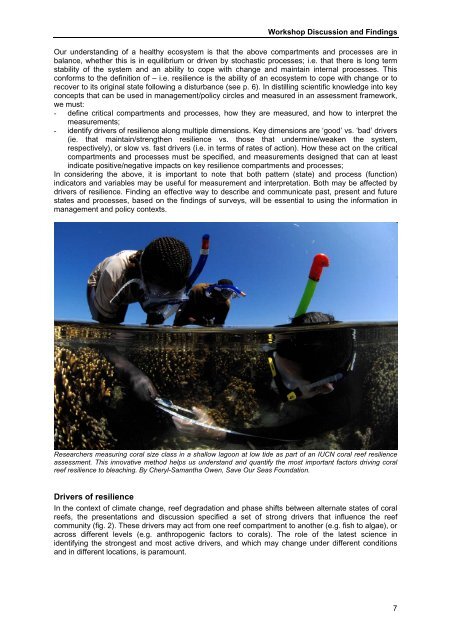Obura2009-IUCN Congress report - Resilience sessions
Obura2009-IUCN Congress report - Resilience sessions.pdf
Obura2009-IUCN Congress report - Resilience sessions.pdf
You also want an ePaper? Increase the reach of your titles
YUMPU automatically turns print PDFs into web optimized ePapers that Google loves.
Workshop Discussion and Findings<br />
Our understanding of a healthy ecosystem is that the above compartments and processes are in<br />
balance, whether this is in equilibrium or driven by stochastic processes; i.e. that there is long term<br />
stability of the system and an ability to cope with change and maintain internal processes. This<br />
conforms to the definition of – i.e. resilience is the ability of an ecosystem to cope with change or to<br />
recover to its original state following a disturbance (see p. 6). In distilling scientific knowledge into key<br />
concepts that can be used in management/policy circles and measured in an assessment framework,<br />
we must:<br />
- define critical compartments and processes, how they are measured, and how to interpret the<br />
measurements;<br />
- identify drivers of resilience along multiple dimensions. Key dimensions are ‘good’ vs. ‘bad’ drivers<br />
(ie. that maintain/strengthen resilience vs. those that undermine/weaken the system,<br />
respectively), or slow vs. fast drivers (i.e. in terms of rates of action). How these act on the critical<br />
compartments and processes must be specified, and measurements designed that can at least<br />
indicate positive/negative impacts on key resilience compartments and processes;<br />
In considering the above, it is important to note that both pattern (state) and process (function)<br />
indicators and variables may be useful for measurement and interpretation. Both may be affected by<br />
drivers of resilience. Finding an effective way to describe and communicate past, present and future<br />
states and processes, based on the findings of surveys, will be essential to using the information in<br />
management and policy contexts.<br />
Researchers measuring coral size class in a shallow lagoon at low tide as part of an <strong>IUCN</strong> coral reef resilience<br />
assessment. This innovative method helps us understand and quantify the most important factors driving coral<br />
reef resilience to bleaching. By Cheryl-Samantha Owen, Save Our Seas Foundation.<br />
Drivers of resilience<br />
In the context of climate change, reef degradation and phase shifts between alternate states of coral<br />
reefs, the presentations and discussion specified a set of strong drivers that influence the reef<br />
community (fig. 2). These drivers may act from one reef compartment to another (e.g. fish to algae), or<br />
across different levels (e.g. anthropogenic factors to corals). The role of the latest science in<br />
identifying the strongest and most active drivers, and which may change under different conditions<br />
and in different locations, is paramount.<br />
7


















